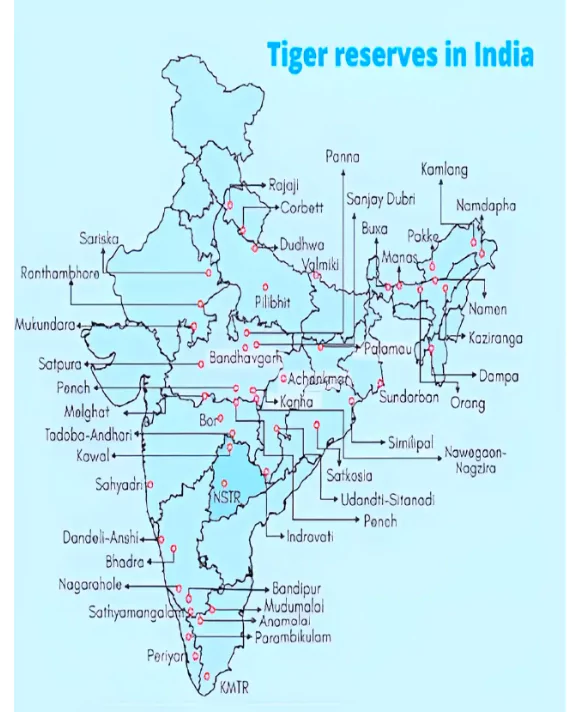Chhattisgarh cleared a proposal to establish a new tiger reserve, the third largest in the country, due to the recent plunge in its tiger population.

- Current Tiger Reserves in Chhattisgarh: Chhattisgarh currently, has three tiger reserves:
- Achanakmar Tiger Reserve in Mungeli district,
- Indravati Tiger Reserve in Bijapur district,
- Udanti-Sitanadi Tiger Reserve in Gariaband district.
- New Tiger Reserve: The Guru Ghasidas-Tamor Pingla Tiger Reserve is Chhattisgarh’s fourth tiger reserve.
- It will integrate the Guru Ghasidas National Park and Tamor Pingla Sanctuary.
- It will be spread across the districts of Manendragarh-Chirmiri-Bharatpur, Koriya, Surajpur, and Balrampur.
- Reasons for establishing a new tiger reserve: According to a National Tiger Conservation Authority report released in July 2023, Chhattisgarh’s tiger population decreased from 46 in 2014 to 17 in 2022.
- National Tiger Conservation Authority Approval: The NTCA had accorded its assent to the proposal in 2021.
- However, the notification of the tiger reserve hanged in fire due to the presence of coal block, oil block and methane gas block in the regions falling under it.
- Benefits: The formation of the new tiger reserve is expected to boost eco-tourism and create employment opportunities for local villagers residing in the core and buffer zones.
- The National Project Tiger Authority will allocate additional funds for reserve operations and new livelihood projects in surrounding villages.
- Comparative Reserve Sizes: Andhra Pradesh’s Nagarjunasagar Srisailam Tiger Reserve is the largest in the country at 3,296.31 sq km, followed by Manas Tiger Reserve in Assam at 2,837.1 sq km. Both reserves have 58 tigers each.
Enroll now for UPSC Online Course
Tiger Reserves in Chhattisgarh
- Achanakmar Wildlife Sanctuary: The Achanakmar Wildlife Sanctuary was constituted in the year 1975 it comprises 557.55 sq kms in the north west forest block of Bilaspur forest division.
- Forest vegetation mainly comprises Sal, Saja, Tinsa, Bija, Bamboo.
- The sanctuary is close to Amarkantak which is the origin of river Narmada.
- Achanakmar Tiger Reserve in Chhattisgarh is a tropical moist deciduous and tropical dry deciduous forest.
- The reserve is also a part of the much larger Achanakmar-Amarkantak Biosphere Reserve.
- Indravati National Park: Indravati National Park is the finest and most famous wildlife park of Chhattisgarh.
- It is located in Dantewada district of Chhattisgarh.
- The Park derives its name from the Indravati River, which flows from east to west and forms the northern boundary of the reserve with the Indian state of Maharashtra.
- Udanti-Sitanadi Tiger Reserve: It was established in 1984. It also includes Udanti and Sitanadi Wildlife Sanctuaries.
- The reserve’s drainage system is primarily fed by the Mahanadi River and its tributaries—Udanti, Sitanadi, Indravan, and Pairi Rivers.
- The area features Tropical Peninsular Sal forest and Southern Tropical Dry Deciduous Mixed forest types.
Check Out UPSC Modules From PW Store
Tiger Reserves in India and National Tiger Conservation Authority (NTCA)
Tiger Reserves in India:
- About: Tiger Reserves are a protected area designated for the conservation of the striped big cats (tigers) is referred to as Tiger Reserve.
- However, a tiger reserve may also be a national park or wildlife sanctuary.
- Project Tiger is a wildlife conservation movement initiated in India to protect the endangered tiger.
- The project was initiated in 1973 by the Ministry of Environment, Forest and Climate Change of the Government of India.
- As of March 2024, there are 55 protected areas that have been designated as tiger reserves.
- Administered by: The tiger reserves in India were set up as a part of Project Tiger initiated in 1973 and are administered by the National Tiger Conservation Authority of Government of India (NTCA).
- Notified by: Tiger Reserves are notified by State Governments as per provisions of Section 38V of the Wildlife (Protection) Act, 1972 on advice of the National Tiger Conservation Authority.
- Core and Buffer Zones- Tiger Reserves in India are divided into two main zones: the core zone and the buffer zone.
- The core zone is the central area where human activities are strictly restricted, allowing tigers to thrive without disturbance.
- The buffer zone surrounds the core area and serves as a peripheral space with limited human activities, offering a degree of protection to the core zone.
Also Read: Tiger Reserves In India 2024
National Tiger Conservation Authority (NTCA):
- About: It is a statutory body set up under the Wildlife (Protection) Act, 1972 which was amended in 2006, for strengthening tiger conservation.
- Objectives
- Legal Authority: Grants legal authority to Project Tiger, ensuring compliance with its guidelines.
- Government Responsibility: Enhances responsibilities of both central and state governments for managing Tiger Reserves.
- Facilitates Memoranda of Understanding (MoUs) with states for better coordination.
- Livelihood Considerations: Addresses the livelihood concerns of communities residing around Tiger Reserves.
- Establishes Critical Tiger Habitats (CTH) areas under the Wildlife Protection Act:
- CTH areas are officially declared by the state government after consultation with a designated group of experts.
- Ensures these areas remain undisturbed to protect tigers while respecting the rights of Scheduled Tribes and other forest-dwelling communities.
|
![]() 8 Aug 2024
8 Aug 2024

